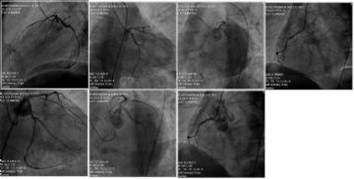Coronary artery spasm is defined as an abnormal contraction of an epicardial coronary artery resulting in myocardial ischemia. Many factors may precipitate coronary artery spasm. Coronary artery spasm frequently occurs at rest, particularly from midnight to early morning. However, in the early morning, even mild exertion may induce coronary spasm. Coronary artery spasm can lead to arrhythmia or rarely sudden death. Coronary spasm is forecast to 3%-4% of patients undergoing diagnostic coronary angiography for chest pain syndromes.
A 41-year-old male was admitted to coronary care unit due to a feeling of tightness in the chest after emotional stress. He had history of smoking for twenty years and treated with antidepressant therapy due to anxiety. Physical examination was normal on admission. There was a mild increase in troponin levels and coronary angiography was performed. A marked narrowing of ∼90% was found in the proximal part of the intermediate artery and obtus marginalis. The right coronary artery was diminitive and there were severe lesions like atherosclerosis(Figure 1), and thus the spasm of this vessels was proposed. The intravenous heparin and nitrogliserin infusion were administered to the patient for 24 hours. After 24 hours coronary angiography was performed again. The spasm of the coronary arteries were resolved after nitrogliserin, heparin and providing sedation. Coronary artery spasm disappeared after eliminating anxiety. (Figure 1). If the coronary spasm suspected, especially patient is young and absent of coronary risk factors, we should wait before percutaneous coronary intervention especially anxious patients.





